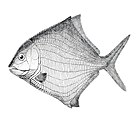
Amblypterus is an extinct genus of freshwater ray-finned fish that lived during the Gzhelian and Cisuralian epoch in what is now Europe and possibly India and Argentina. Potential indeterminate records stretch as far back as the early Carboniferous.

Atopocephala is an extinct genus of prehistoric freshwater ray-finned fish that lived during the Middle Triassic epoch. It contains a single species, A. watsoni from the Karoo Supergroup of South Africa. A potential indeterminate species was known from the Timezgadiouine Formation of Morocco, but is now considered an indeterminate actinopterygian.
Daedalichthys is an extinct genus of prehistoric freshwater ray-finned fish that lived during the Early Triassic epoch. It contains a single species, D. formosa from the Olenekian-aged Cynognathus Assemblage Zone of South Africa. It was previously classified in Dictyopyge.

Ebenaqua is an extinct genus of bobasatraniiform bony fish that lived during the Lopingian epoch, of what is now Blackwater, Queensland, Australia. Fossils are found in the Rangal Coal Measures, which are Changhsingian in age. Its type and only species is Ebenaqua ritchiei.
Inichthys is an extinct genus of prehistoric marine bony fish that lived during the Lopingian epoch. Fossils were recovered in the Kuznetsk Basin, European Russia.

Acrolepis is an extinct genus of prehistoric marine bony fish that lived from the Famennian stage of the Devonian to the early Triassic epoch. Some species from the Early Triassic of Tasmania are also ascribed to Acrolepis.
Cycloptychius is an extinct genus of prehistoric freshwater & marine ray-finned fish that existed throughout much of the Carboniferous period in Eurasia, and possibly into the Early Permian in South Africa. It was a member of the Rhadinichthyidae, a family of basal ray-finned fish that was formerly placed in the now-paraphyletic order Palaeonisciformes.
Charleuxia is an extinct genus of prehistoric freshwater ray-finned fish that lived during the Asselian age in what is now Burgundy, France (Autun). It may possibly belong to the genus Paramblypterus.
Decazella is an extinct genus of prehistoric freshwater ray-finned fish that lived during the late Carboniferous period. It contains a single species, D. vetteri from the Gzhelian (Stephanian) age of what is now Occitania, France.
Urosthenes is an extinct genus of prehistoric bony fish that lived during the Lopingian to Middle Triassic epochs in what is now New South Wales, Australia.
Gardinerichthys is an extinct genus of freshwater actinopterygian bony fish from the Cisuralian epoch of Germany, and the middle Permian of India. The type species, G. latus, was discovered in Asselian aged layers (Rotliegend).

Prohalecites is an extinct genus of ray-finned fish from the Ladinian and possibly Carnian (Triassic) of Italy. It is the oldest known teleosteomorph, a group that includes extant teleosts and their close fossil relatives.
Eurynotoides is an extinct genus of prehistoric bony fish in the family Eurynotoididae of the order Eurynotoidiformes.

Saurorhynchus is an extinct genus of carnivorous bony fish that lived during the Early and Middle Jurassic epochs. Fossils have been found in Europe and North America (Canada). It is commonly found in pelagic and lagoonal deposits, but mostly marine. Largest specimens can grow up to 1.9 metres (6.2 ft).

Bourbonnella is an extinct genus of prehistoric freshwater and coastal marine ray-finned fish that lived during the late Mississippian (Carboniferous) and Asselian in what is now Burgundy, the Czech Republik, and Utah, with other remains known from elsewhere. The genus was named by Daniel Heyler in 1967.
Gardinerpiscis is an extinct genus of prehistoric actinopterygian fish that lived during the Kungurian age of the early Permian epoch in what is now Kazakhstan. It was originally named "Gardineria" by Kazantseva-Selezneva (1981). Because this genus name was already given to an extant scleractinian coral, the new name Gardinerpiscis was erected for the Permian fish. The genus includes a single species (monotypy): Gardinerpiscis akkolkensis.
Turseodus is an extinct genus of ray-finned fish found in Late Triassic freshwater sediments of the United States. Two species have been described, T. acutus from the Lockatong Formation of Pennsylvania, and T. dolorensis from the Chinle Formation of Colorado.

Challaia is an extinct genus of prehistoric freshwater ray-finned fish that lived during the Triassic period in what is now Argentina (Mendoza). Two species are known, C. magna, most likely from the Cerro de Las Cabras Formation, and C. elongata from the Los Rastros Formation. Three other species, C. multidentata, C. striata and C.? cacheutensis, are considered nomina dubia.
Brazilichthys is an extinct genus of prehistoric freshwater ray-finned fish that lived during the Cisuralian epoch in what is now Maranhão, Brazil. The type and only species, B. macrognathus, is known from a single partially complete skull, which was recovered from the Pedra de Fogo Formation near Pastos Bons, Maranhão, Brazil.

Mamulichthys is an extinct genus of prehistoric bony fish that lived during the Urzhumian age in what is now European Russia. The type and only species, Mamulichthys ignotus, is known from a single specimen preserving the skull and anterior body portion, which was recovered from the uppermost part of the Amanak Formation. Holotype of M. ignotus is the first complete skeleton of discordichthyiform.
















